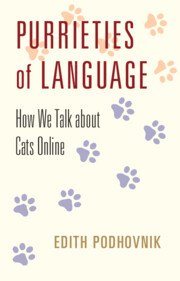Book contents
- Frontmatter
- Contents
- Illustrations
- Tables
- Acknowledgements
- 1 The Cativerse
- 2 The Feline Territory of Language
- 3 Meowlogisms
- 4 Da Kittehz
- 5 Virtual Furever Homes
- 6 Multimeowdality
- 7 Meow and More
- 8 Going on Pawtrol
- 9 Linguistic Scratching Posts
- 10 #StatsWithCats
- 11 Cattitude and Purrception
- Appendix Meowscellaneous
- References
- Clawssary
- Index
- Frontmatter
- Contents
- Illustrations
- Tables
- Acknowledgements
- 1 The Cativerse
- 2 The Feline Territory of Language
- 3 Meowlogisms
- 4 Da Kittehz
- 5 Virtual Furever Homes
- 6 Multimeowdality
- 7 Meow and More
- 8 Going on Pawtrol
- 9 Linguistic Scratching Posts
- 10 #StatsWithCats
- 11 Cattitude and Purrception
- Appendix Meowscellaneous
- References
- Clawssary
- Index
Summary
The chapter ’Multimeowdality’ looks at the interplay of textual and visual elements in social media and approaches multimodality in computer-mediated communication (CMC) and computer-mediated discourse (CMD). Digital discourse has evolved from text-only discourse to multimodal interactions involving text, audio, video, and graphics. The chapter shows the CMC modes and semiotic modes used in multimodal interaction. Based on examples from cat-related digital spaces, it applies the faceted classification tool and the CMDA tool to describe communication on the interactive multimodal platforms. The chapter describes the various visual elements, such as photos, videos, memes, meme-like photos, GIFs, emoticons, emoji, and stickers, and discusses their functions in discourse.
Keywords
Information
- Type
- Chapter
- Information
- Purrieties of LanguageHow We Talk about Cats Online, pp. 138 - 172Publisher: Cambridge University PressPrint publication year: 2023
